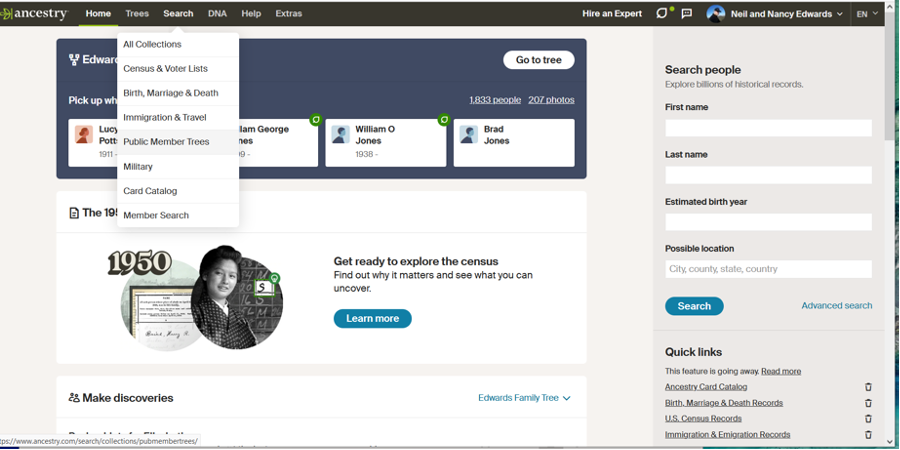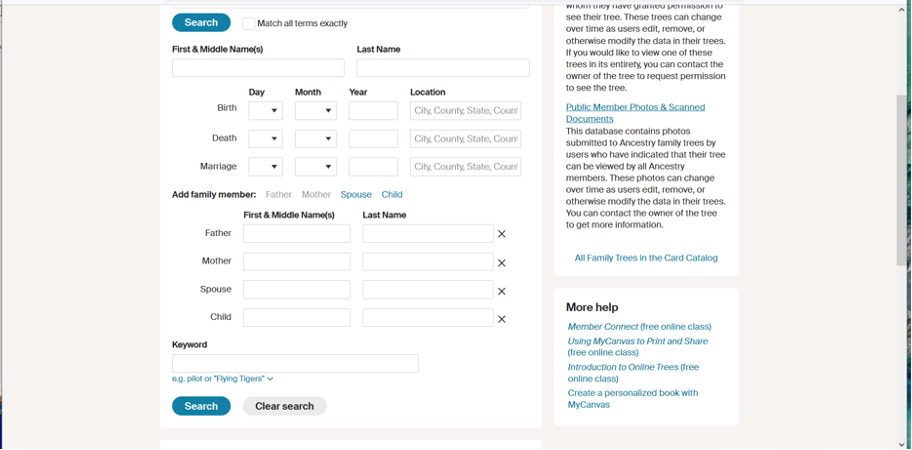What Are Ancestry Public Member Trees?
You might have noticed that Ancestry has something called Public Member Trees. There are a huge number of these trees and, in this post, we cover what they are, how they work, and how to search through them.
There are over 100 million family trees housed on Ancestry databases globally as more and more people become interested in their personal genealogy. These trees range from fully fleshed out documents with hundreds or thousands of names to small three-person trees that never really got off the ground.
Ancestry is Our Top Recommendation
If you love genealogy and family history research, then you must know Ancestry. They are the best way to discover the rich stories of your family!
With over 30 billion (seriously!) records in their database, you can research your family and discover amazing details you may never have known about your ancestors.
With a 14-day free trial, it's very easy to get started and discover your past!
Get Started →Every person is different with regards to how they view the need for privacy when it comes to their family information so some chose to not share these trees with everyone. Those who decide to keep their tree secret create what is known as a private family tree.
Although most people choose to have a public tree you can choose upon creating your tree to keep it hidden from all other users. As a researcher who sometimes will use Ancestry to create theoretical trees, I will set these trees as private so as not to put potentially misleading information out there.
Public Member Trees
A public member tree is a tree that has been created by a person who has chosen to make their tree available for others to view. Although to be more accurate the default setting when you start a tree is for it to be public. You do have to choose to make a tree private so for those just starting out, this may be important to note.
Public trees are 100% user-created so details that have been inputted and documents have been attached to persons in that tree are done so by the tree's owner or an authorized editor.
Viewing Public Trees
You may come across your ancestors mentioned in other trees, if they are listed as public you may also be able to view what someone else has regarding your ancestor. It is important to note however that just like many of Ancestry's documents you do need a valid membership to view these trees.
If you have an account but no active membership you will not be able to view these trees. This is of course unless it is a tree that you yourself created or it is a tree that the owner gave you access to through an invite.
Searching for an Ancestor in Public Trees
As mentioned, sometimes your ancestors or people you are researching may appear in public trees throughout Ancestry. So it might be prudent to know a quick and easy way to search for your target person in other trees.
On the home page for Ancestry, there is a toolbar across the top. Click on the search section and scroll down to “Public Member Trees.” When you click this a search form pops up that you can fill with the information you have regarding the person of interest.

Once you have inputted all you know about this person click the blue search button and wait for your results. You should receive a list of public trees that feature someone who matches the information you provided.

How Accurate Are Public Trees?
When you think of public trees on Ancestry consider them somewhat akin to Wikipedia. They are user-created documents that may contain inaccuracies and on occasion pure fabrications. This is not to say that they are all completely wrong but we should use caution.
In my own research, I have countless times found family tree connections that suggested parents who died years before a child’s birth. It is also very common to see people who are only a few years older than their proposed children.
I know in my early days of research that I made mistakes, made assumptions and did not always check the details thoroughly on my trees. Ultimately you learn from your mistakes and pay for them by having to fix your errors.
It is therefore always important that you do not just assume that the information on someone else’s tree is accurate. The temptation to believe that a common ancestor you share with them is descended from Henry VIII is understandable but is it true?
Double-check the proof they have on their tree. If there is none then why isn’t there? Do the research yourself to see if you can find anything reputable to confirm the match. If they can’t supply proof and you cannot find any evidence either then do not add that information to your tree.
Conclusion
Public member trees are a somewhat tenuous potential tool to help your own ancestry research. They have been created by people who may be related to you through a common ancestor and they have already researched that person.
Although sometimes the person who created the tree may have done a very good and thorough job we must remember that if they show no evidence of the accuracy of the research we have to confirm it ourselves. I mean there’s no harm looking out of the window even if the weather person says that it’s raining.
Link To or Reference This Page
We spent a lot of time downloading, cleaning, merging, and formatting the data that is shown on the site.
If you found the data or information on this page useful in your research, please use the tool below to properly cite or reference Name Census as the source. We appreciate your support!
-
<a href="https://namecensus.com/blog/what-are-ancestry-public-member-trees/">What Are Ancestry Public Member Trees?</a>
-
"What Are Ancestry Public Member Trees?". NameCensus.com. Accessed on April 19, 2024. https://namecensus.com/blog/what-are-ancestry-public-member-trees/.
-
"What Are Ancestry Public Member Trees?". NameCensus.com, https://namecensus.com/blog/what-are-ancestry-public-member-trees/. Accessed 19 April, 2024
-
What Are Ancestry Public Member Trees?. NameCensus.com. Retrieved from https://namecensus.com/blog/what-are-ancestry-public-member-trees/.
